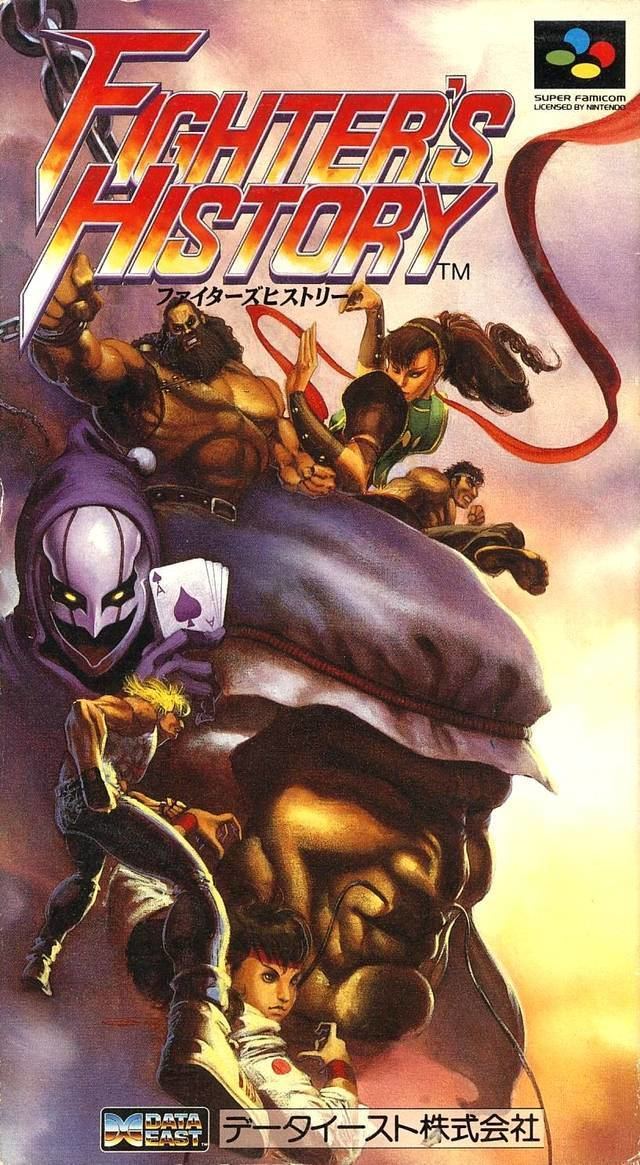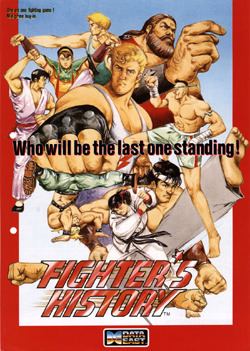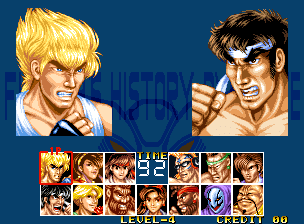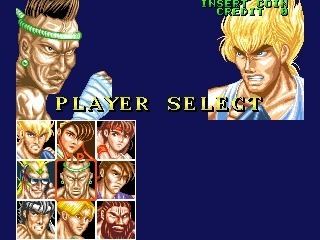Developers Data East Genre Fighting game | ||
 | ||
Original release Fighter's HistoryMarch 1993 (Arcade)May 27, 1994 (Super Famicom)August 1994 (SNES)FH DynamiteMarch 17, 1994 (Neo Geo)April 28, 1994 (Neo Geo CD)July 4, 1997 (Sega Saturn)Mizoguchi Kiki Ippatsu!!February 17, 1995 (Super Famicom) Spin-offs Garou Densetsu vs. Fighter's History Dynamite Games Fighter's History Dynamite, Fighter's History | ||
Fighter's History (ファイターズヒストリー, Faitāzu Hisutorī) is a series of competitive fighting games that were produced by Data East during the 1990s. The original Fighter's History was first released for the arcades in 1993 and then ported to the Super Nintendo Entertainment System in 1994. Two different sequels were produced: Fighter's History Dynamite (ファイターズヒストリーダイナマイト, Faitāzu Hisutorī Dainamaito), known in Europe as Karnov's Revenge, for the Neo Geo in 1994, followed by Fighter's History: Mizoguchi Kiki Ippatsu!! (ファイターズヒストリー 〜溝口危機一髪!!〜, Faitāzu Hisutorī: Mizoguchi Kiki Ippatsu!!, "Mizoguchi's Moment of Crisis!!"), released exclusively in Japan for the Super Famicom in 1995.
Contents
- Retro fighting game review fighter s history snes
- Fighters History
- Fighters History Dynamite Karnovs Revenge
- Fighters History Mizoguchi Kiki Ippatsu
- Characters
- History
- Soundtracks
- Other appearances in media
- References

The main unique feature of the Fighter's History series is its "weak point system". By repeatedly hitting an opponent's weak point, the player can temporarily stun them once per round, leaving the opponent open for an attack. The location of an opponent's weak spot varies with each character and is usually represented by a specific article of clothing (i.e.: a headband, a vest, a mask).

Retro fighting game review fighter s history snes
Fighter's History


The original Fighter's History was first released as an arcade game in March 1993. The game uses a six-button control configuration similar to Street Fighter II and its iterations, as well as an alternate version of the first Street Fighter, with three punch buttons and three kick buttons, each for different strength levels (light, medium, and heavy). There are a total of nine playable characters, as well as two non-playable boss characters at the end of the single-player tournament. The final boss and sponsor of the tournament is revealed to be Karnov, the protagonist of the Data East action game of the same name.
In this installment hitting an opponent's weak point will not only stun the opponent, it will also cause the opponent to sustain greater damage when the weak point is repeatedly struck afterward.
The game was ported to the Super Famicom in Japan on May 27, 1994, and for its American counterpart, the Super NES, on August of the same year. The two boss characters, Karnov and Clown, are both playable in the home version through the use of a code.
Electronic Gaming Monthly gave the SNES version a 6.75 out of 10. They commented that the graphics are average, but highly praised the controls as exceptional for a fighting game. GamePro gave the SNES version a negative review, calling the game "an unremarkable SF knock-off with solid but slow game play", and heavily criticizing the "bland" character design.
Fighter's History Dynamite (Karnov's Revenge)
Fighter's History Dynamite, also titled Karnov's Revenge in certain markets, was released for the arcades March 17, 1994. Due to change of hardware to SNK's MVS platform, the control configuration was reduced from six attack buttons to just four (only light and heavy attacks are available this time). Likewise, the game was released for the Neo Geo home console, as well as the Neo Geo CD, on April 28, 1994.
A new gameplay feature is introduced in the form of "one-two attacks". When the player presses a heavy attack button while performing a light attack or blocking, the interval between light attacks is reduced, making combos easier to perform. While this feature is not mentioned on the instruction card, the final page of the home Neo-Geo version's manual mentions it, describing as the "one-two attack" system.
All eleven fighters from the previous game return (including the bosses Clown and Karnov, who are now playable) and are joined by two new characters: Yungmie, a female taekwondo exponent from Korea, and Zazie, a karate practitioner from Kenya, for a total of 13 characters. Karnov is the only returning character who was given entirely new sprites. Most of the returning characters were given new special techniques (with a few exceptions), including hidden techniques which are not listed on the instruction card (the manual for the home version hints of their inclusion). The Ox that appeared in the bonus rounds in Karate Champ appears in this game as a secret boss if the player completes the game on the Normal setting or above without losing a round. The Ox is an unplayable character.
On release, Famicom Tsūshin scored the Neo Geo version of the game a 25 out of 40. GamePro rated it as a modest improvement over the first game, with faster paced action but the same lack of likeable characters. However, they said the new characters are better than the old ones, especially Yungmie and her unique trait of using only her legs to attack. In addition to the ports for the Neo Geo home consoles, Fighter's History Dynamite was released for the Sega Saturn exclusively in Japan on July 4, 1997. The Saturn version allows players to assign all four basic attacks into a single button (C and Z by default), which is required for certain characters in order to perform certain special moves. A Virtual Console reissue of the Neo Geo version was released for the Wii in Japan on June 8, 2010 and in North America on December 27, 2010. It was also added to Zeebo on April 23, 2010.
Fighter's History: Mizoguchi Kiki Ippatsu!!
Fighter's History: Mizoguchi Kiki Ippatsu!! ("Mizoguchi's Moment of Crisis!!") was released exclusively in Japan for the Super Famicom on February 17, 1995. It was the only game in the series released exclusively for the home market. Originally planned as a port of Fighter's History Dynamite, many changes were made to the game, including the addition of a new game mode where Mizoguchi is the protagonist. The story takes place after the events of Dynamite. In addition to the story-based Mizoguchi Mode, there are also three new game modes (Practice, Tag Battle, and Survival) in addition to the traditional CPU Battle and 2-Player Versus Modes.
There are only nine playable characters in this installment, as five of the characters from the previous Fighter's History games were cut from the roster (Ray, Jean, Matlock, Samchay, and Marstorius). Chelnov, the main character from Data East's arcade game Atomic Runner Chelnov, appears in this game as the final boss, as well as a hidden character playable via a code. Ray, Jean, Matlock, Samchay and Marstorius, while not playable, appear during the story sequences of the Mizoguchi Mode.
Like the Saturn version of Dynamite, the player can assign all four basic attacks into a single button (R by default). The Practice Mode is actually a tutorial that teaches players how to perform various combos with each character. By completing all of the exercises given, the player will be taught how to perform a new special technique for their character.
On release, Famitsu magazine scored Mizoguchi Kiki Ippatsu a 25 out of 40.
Characters
History
At the time of the first game's release, Capcom U.S.A. sued Data East Corp. over Fighter's History due to what Capcom U.S.A. felt were infringements on its Street Fighter II property. Capcom also filed similar claims against Data East in Japan. Data East Corp.'s largest objection in court was that their 1984 arcade game Karate Champ was the true originator of the competitive fighting game genre, which predated the original Street Fighter by three years. Judge Orrick set an October 31, 1994 trial date, stating that he could not deny "the strong evidence that it set out to copy Street Fighter's success," noting similarities such as a Chun-Li clone and several comparable special moves. However, Capcom U.S.A. lost the case on grounds that the copied elements were scenes a faire and thus excluded from copyright.
Soundtracks
All three titles in the series had their soundtracks published the CD albums exclusively in Japan. On June 18, 1993, the original arcade version of the original Fighter's History soundtrack was released by Pony Canyon and Scitron Label, while the SNES version's soundtrack was released by Project EGG on July 19, 2011, which can be downloaded on the official Project EGG website. On March 18, 1994, the soundtrack of the Neo-Geo MVS / Neo-Geo AES version of Fighter's History Dynamite / Karnov's Revenge was added with the Neo-Geo MVS / Neo-Geo AES soundtrack of Windjammers (known in Japan as Flying Power Disc) by Pony Canyon and Scitron Label in an album titled Fighter's History Dynamite / Flying Power Disc. This album features two exclusive arranged versions of "DYNAMITE" (from Fighter's History Dynamite / Karnov's Revenge) (Arrange Version begins) and "SHOOOT!!" (from Windjammers / Flying Power Disc). On July 26, 2011, Project EGG published the soundtrack of the Neo-Geo MVS / Neo-Geo AES version of Fighter's History Dynamite / Karnov's Revenge alone without the arranged version of "DYNAMITE", which like their other soundtrack, also can be downloaded on the official Project EGG website. On August 26, 2005, Insanity Naked Hunter Co., Ltd. published the same version Project EGG published, but exclusively as a CD album. On March 19, 1995, Pony Canyon and Scitron Label published the soundtracks of the Neo-Geo CD version of Fighter's History Dynamite / Karnov's Revenge and Fighter's History: Mizoguchi Kiki Ippatsu!! both in the album titled Fighter's History Dynamite NEO-GEO CD & Mizoguchi Kiki Ippatsu!!.
Other appearances in media
Outside of the Fighter's History series, Makoto Mizoguchi became prominent when he appeared in several other video games. He appeared in the Sega Saturn and Sony PlayStation versions of Data East's 1995 Water Margin-based fighting arcade game, Outlaws Of The Lost Dynasty as an extra character. The Sega Saturn version is known outside Japan as Dark Legend. He and Liu Yungmie later appeared in its Japan-exclusive semi-sequel, titled as Suiko Enbu: Fuuun Saiki. Five years after Data East went out of business while giving their video game rights to G-Mode, Paon, WorkJam and Crea-tech, SNK Playmore signed a deal with G-Mode to use their characters from the Fighter's History series in two SNK Playmore titles. Makoto Mizoguchi became the only character from the Fighter's History series as a special guest character in an upgrade to KOF: Maximum Impact 2 titled as KOF: Maximum Impact Regulation A, to promote the Japan-exclusive cell phone game specifically featuring the cast of Fatal Fury Special and Fighter's History Dynamite titled as Garou Densetsu vs. Fighter's History Dynamite. Makoto Mizoguchi also appeared in Joe & Mac Returns as one of the enemies in the game, and as a hidden character in Kenka Bancho: Badass Rumble.
In the 1998 movie The Replacement Killers, a Fighter's History arcade cabinet appears along with several other arcade cabinets.
